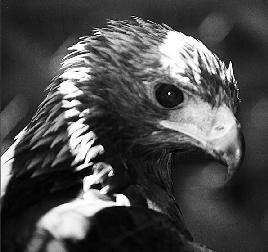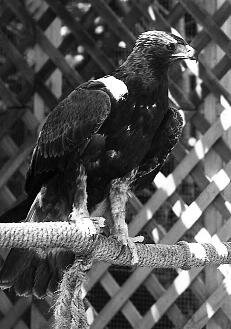
Board of Directors:
Acting President
Sandra Skolnikk
Treasurer
Martha Kudlacik
Secretary
Beth Visbeck
Director at Large
Lori Isakson
Director at Large
Jeanne Fouts
Clinical Advisor
Susie Brain
The Rescuer:
Editing and Layout
Michele Mandell
Initial Design by
Marty Johnson
Contributors
Karen Hoyt
Sandra Skolnik
Brad Milliken
The Rescuer
Volume XXIV -- Issue Two -- July 1998
SUCCESS STORY: A Memorable Start to the Season
by Karen Hoyt, Raptor Team
 |
|
A golden eagle makes a rare visit to WRI this spring |
The Wildlife Rescue raptor team was ready for the season to start, but we hadn't seen any birds yet. We assumed it was going to be a slow season. Then on May 11, I got a call from my WRI colleague Liz Beard, who excitedly told me that someone had called her regarding a golden eagle in distress. I cleared my calendar for the afternoon and headed out for the shelter feeling a bit skeptical. Our eagle calls usually turn out to be red-tailed hawks or young pigeons -- but not this time. Our source, Mike Rigney was well informed. An experienced birder and a researcher at the Coyote Creek Riparian Station (CCRS) in Alviso, he had found a young female eagle sitting helplessly near a "sludge lagoon" at the county water treatment plant near the banding station.
Covered in sludge and wrapped in a burlap sack for protection, the bird was in shock and dehydrated. After preparing her for transport, we brought her to my new large aviary, which is in a quiet part of my yard. We left her to rest peacefully and get stabilized.
That evening, after she seemed to be stable, apprentice raptor team member Denny Brisley and I hooded the bird and carried her into my large walk-in shower to remove the sludge covering her feathers. The sludge not only prevented her from flying, but it could be toxic if ingested. My husband found us to be quite a sight in the shower in our shorts and bathing suits with the soapy eagle. After the shower, we crated the eagle and placed the crate on a heating pad for the night.
Over the next several days, the eagle got plenty of visits from our resident veterinarian, Tina Peak, who monitored the bird, took blood samples, provided subcutaneous fluids and injected antibiotics in case of sludge ingestion. Our goal was to help the eagle gain weight, start flying again and preen herself to become waterproof. We gave her a large horse trough to bathe in, plenty of dead rats to eat and peace and quiet (other than interruptions for medication).
After five days and a lot of work, she was waterproof and weighed 11 pounds. I began looking for a release site. The head ranger at Ed Levin County park in Milpitas volunteered to drive the eagle and me up into a remote part of the park.
 |
|
Our rescued "sludge eagle" rests in Karen |
On May 19, the eagle ate a healthy breakfast, and I drove her to the site. The rolling oak woodland and expansive grassland appeared to offer a perfect eagle habitat. Suddenly, as if to confirm this impression, two adult golden eagles soared into view. Since we knew that no eagles were nesting in the park, we deemed it safe for a release into the pair's hunting territory. As soon as the blanket was removed from the crate, our eagle seemed to know that she was to be free and charged the crate door. There was no hesitation as the door was opened, and she flew to freedom.
WRI has received only three golden eagles prior to this one. The first was shot in the wing and developed an infection, the second was an electrocution victim, and the third had severe lead poisoning. Our "sludge eagle" was young and healthy; she just needed a helping hand to get back to the wild. If she had needed long-term care, she would have been transferred to the Wildlife Education and Rehabilitation Center in Morgan Hill for flight time in their huge (100'x30'x20') flight aviary. Our Raptor Team is actively searching for space to build a large conditioning flight cage to house raptors prior to release. We are also looking for donations of clean food for these amazing birds.




 Next Issue
Next Issue